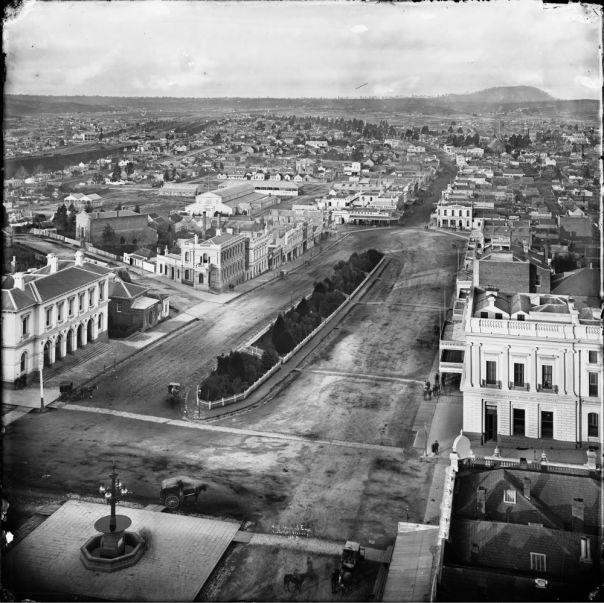1 May
Ballarat is central to the story of the Victorian Goldrush – one of the most significant goldrushes in the world. Gold was first discovered at Golden Point in August 1851, which resulted in thousands of people flocking to the gold fields to try their luck and seek their fortune.
Recent fieldwork and historical research indicate that it is likely that important historic archaeological sites survive buried beneath parts of the modern city. In light of this, in mid-2023 the Heritage Council of Victoria provided funding for Heritage Victoria’s archaeology team to develop an Archaeology Management Plan for Ballarat to identify and list historical archaeological sites. The plan will also identify some sites in Bendigo.
What type of sites are we finding?
Historic plans map out the city as it was in the 19th century. The Revised Town Plans of Main Road (1857-1859), show Ballarat’s first commercial precinct and show the locations of early hotels, apothecaries, banks, and stores, as well as mining features. These plans tell a story of how miners and immigrants made Ballarat their own city and can tell archaeologists how people lived at the start of the Gold Rush in Victoria.

As a result of the mass amounts of mining and dirt moving, throughout the 1850s the street level was raised and buried by sludge. This 1859 article from the Geelong Advertiser shows the concerns from the townspeople about sludge burying them alive;
"The sludge is rolling down, like a lava-tide, upon the cities of Ballarat and Sandhurst, threatening to submerge them, and thus preserve them, like Pompeii or Herculaneum, for the delectation of antiquaries a thousand-years hence. No less overpoweringly does the avalanche of imported sludge shoot into the seaboard towns, bearing down all native industry as effectually, as the sea would sweep the fields of Holland if her dikes were thrown…"
New technologies, including Digital Elevation Modelling, show the ground surface as it was in 1858, and when compared with 2019 Lidar, archaeologists can assess if a site is within an area likely to be impacted by sludge. The presence of sludge across a site means that the site is likely to be well preserved.
What is an Archaeology Management Plan?
An archaeology management plan identifies locations that are likely to contain archaeological features, deposits and artefacts. Using historic maps and plans, images and other sources archaeologists work out the location of potential sites. The current condition and building history of properties is also assessed to identify places where recent works may have removed all archaeology.
Managing historical archaeology and the Heritage Act 2017
The aim of the project is to identify sites for inclusion in the Victorian Heritage Inventory. The Victorian Heritage Inventory is a list of all the known historical archaeological sites in Victoria, established under the provisions of the Heritage Act 2017.
In Victoria, the Heritage Act provides ‘blanket protection’ for all historical archaeological sites, including ones that are not recorded by Heritage Victoria or listed in the Inventory. Therefore, the inclusion of a site on the Heritage Inventory should not be thought of as a new planning control that is added to a place. Rather, the addition of a site to the Inventory should be considered a strategic tool, which adds a layer of information and awareness to facilitate place management.
In the absence of clear information about the likely location of archaeological sites, there is a risk that development projects will be delayed by the unexpected discovery of archaeological remains after the project has commenced.
Under the terms of the Heritage Act it is necessary to obtain a Consent to authorise any works that may affect historical archaeological remains at a site. In most cases, Heritage Victoria will allow Heritage Inventory sites to be disturbed, subject to the undertaking of a program of archaeological investigating, recording, reporting and artefact management.
Information sessions
Owners will be notified via a letter if their property is added to the Victorian Heritage Inventory. Victorian Heritage Inventory information is also publicly available on VicPlan and the Victorian Heritage Database.
Heritage Victoria and the City of Ballarat will undertake a program of community education and engagement to provide information about the Archaeology Management Plan to owners, other parties and interested members of the public.
Two in person ‘Meet the Archaeologist’ sessions will be held at the Ballarat Town Hall Trench room from 4:00PM to 6:00PM on May 3, 2024, and June 13, 2024.
If your property may be impacted, or you have an interest in in hearing about the archaeology of brilliant Ballarat, please RSVP through MySay Ballarat.




Page last updated: 01/05/24


